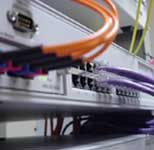Peering Key to Managing Bandwidth Bills
Peering is a traffic management strategy that allows large companies to save huge sums of money on their bandwidth bills and improve their network performance.
June 9, 2009

cables
Equinix is the industry leader in peering, a traffic management strategy that can help large companies save money on their bandwidth bills and improve network performance. The explosive growth of Internet traffic, driven by the emergence of online video and photo sharing, has made peering perhaps more important than ever.Peering allows two providers exchanging large volumes of traffic to save money by connecting directly, rather than routing traffic across their paid Internet connections. Peering is often free as long as the amount of traffic exchanged is not out of balance, providing substantial cost savings for bandwidth for high-traffic sites and networks. Internet exchanges allow participants to peer with other providers connected to the exchange.
Equinix and other peering specialists provide the physical network connections between networks. This can be done by running a cable between the two companies' network equipment, which is known as a cross-connect. This is an effective means of connecting one network to another.
But what if your company needs to exchange traffic with many different providers? Each Equinix data center includes The Equinix Exchange, a central meeting place where companies can peer with multiple providers, exchanging traffic over a 10-Gigabit Ethernet fabric. The ability to connect to so many key partners in a single location makes peering points critical to the growth and network management for companies with large Internet operations.
Equinix is the largest player in the peering arena. Other companies with significant peering businesses include Switch and Data (which operates the former PAIX interconnection sites), Terremark, Telehouse, Telx, CRG West and Interxion.
Peering is most often in the news when two companies have a dispute over the details of their traffic exchange agreements. When the balance of traffic between peering partners gets out of whack, someone usually wants to get paid. If they can't work things out, one provider may "unplug" the peering connection, causing problems for users who've come to rely on their ability to access the other network.
An example: During the 2008 peering dispute between Cogent and Telia, gamers whose ISPs relied solely on Cogent for connectivity were unable to access World of Warcraft, the world’s most popular online game.
Peering disputes are really loud business negotiations, with angry customers used as leverage by either side. They usually end with one side agreeing to pay up or manage their traffic differently.
About the Author
You May Also Like

.jpg?width=300&auto=webp&quality=80&disable=upscale)





